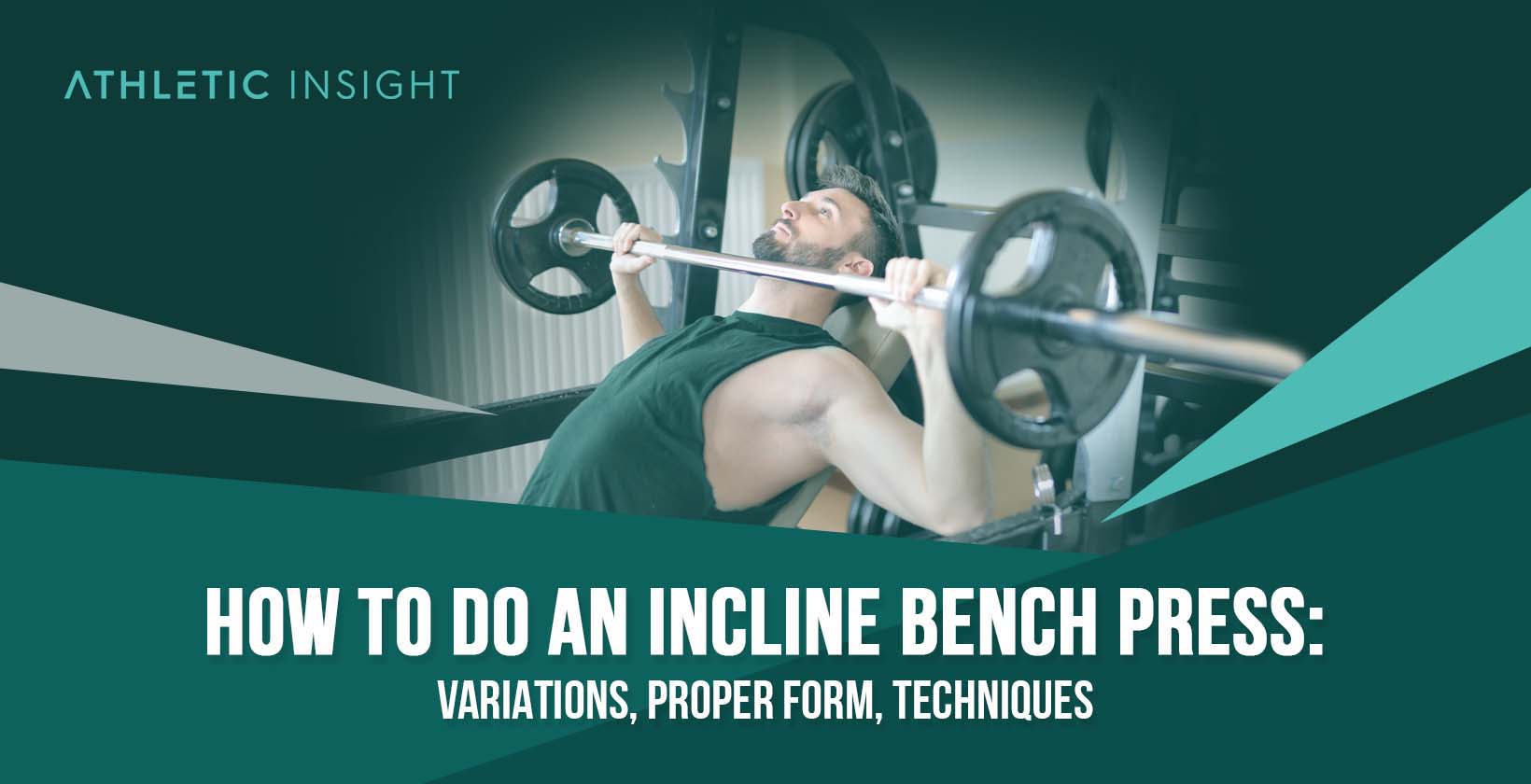The incline bench press is a compound exercise that targets the pectoralis major, anterior deltoid, and the triceps brachii medial head. The incline bench press is a variation of the traditional bench press and is considered a moderately difficult muscle movement to perform.
The incline bench press is an advanced exercise that will benefit all athletes looking for stronger and more developed pectoral muscles. It is an especially common exercise for bodybuilders looking to target the upper chest. While it is not a lift conducted in the Olympics, CrossFit, or Strongman competitions, these types of athletes will still benefit from the exercise.
To perform the movement, you first need a spotter. Once a spotter is in place, lie back on the incline bench press equipment and place your hands on the barbell. Then plant your buttocks, back, head and feet firmly to avoid wasted potential. If you do not have an incline bench press, you’ll need a regular bench and dumbbells.
Once your hands are in place, press the barbell straight up like a standard bench press, locking the elbows. Then, slowly bring the barbell down towards your chest all while maintaining a tight core and retracted shoulder blades. Once the bar touches your chest, press it back up to the starting position for a completed repetition.
No matter the degree of your incline, the incline press will target the upper pecs, the anterior deltoid, and the triceps. The angle of the incline bench also puts less stress on your rotator cuff which is a common injury for the incline bench press. which is why mastering form is the number one goal before adding weight.
How to Perform Incline Bench Press with Proper Form
Whatever type of bench press you choose to utilize, you should always practice proper form. If done correctly, Incline Bench Press is an effective workout to include in your chest exercise routine. Neglecting to practice proper form leaves you susceptible to the common incline bench press injuries such as tears and strains due to misaligned joints, muscles, and tendons.

Aside from avoiding injury, practicing the correct form can help you get the most out of your workouts. Save energy by cutting out wasted movements and ensure you target the regions of your body that you want to develop. Here are some tips to practice proper form.
- First and foremost, watch your elbows. Maintaining the correct angle at the elbows can make or break your chest activation goals.
- Secondly, you should ensure that your shoulders are angled down and back through your entire range of motion. This way your chest can take more of the load instead of your shoulders.
- Also, never try to lift more weight than you can handle. If the weight is not under your total control and you use your chest to bounce the barbell or dumbbells, you are more apt to suffer an injury to the sternum or rib cage.
- Another tip is never to let your butt raise off the bench when doing incline bench presses. The only gap you feel should be between the incline bench and your lower back.
- Be sure to align your hands properly before doing an incline barbell bench press or an incline dumbbell bench press. Even one misalignment can hinder your progress and lead to serious injury.
- Your feet should never come off the floor when performing incline bench presses. Keeping your feet planted means the power comes from the floor, up through your legs, and into your chest. If your feet slip, you can lose muscle activation or cause yourself a painful injury.
- Monitor your breathing when performing incline bench presses to enable better muscle activation and foster better mind-to-muscle connection.
What is the Best Angle for Incline Bench?
The best angle for incline bench is a 30 degree angle. However, the angle at which the bench is set will impact the muscles that are targetted. So, the best angle depends on the specific goals. For example, an incline that is more than 30 degrees will start to target the upper pectoral and shoulders whereas a flatter incline (below 30 degrees) will target the lower pectoral muscles and triceps.
What are the Phases of Conventional Incline Bench Press?
You can’t understand the many benefits of incline bench press resistance training without knowing the importance of the phases (or stages) used in this exercise. The incline bench press consists of two specific movements: concentric and eccentric.
Concentric movements shorten your muscles as they produce force. When you raise your weights on an incline bench press, this is a concentric motion. Eccentric movements lengthen your muscles as they produce force. When you lower your weights during an incline bench press, this is an eccentric motion.
Learning what incline bench press muscles worked lets you focus on the correct areas during your workout for the quickest and most noticeable results.
1. Eccentric (Lowering) Phase of Bench Press
During the lowering phase of an incline bench press, your lower PECS and anterior deltoid work together to flex your arm muscles.
You may feel stronger during the eccentric phase of your lift because you are holding the weight back.
2. Concentric (Lifting) Phase of Bench Press
The lifting phase of an incline bench press forces your lower pecs to work hard and allows for the complete extension of the arm. They are aided by the triceps and the anterior deltoid.
What Are the Mistakes for Incline Bench Press Form?
When you neglect proper incline bench press form, you could fall victim to some of these common Incline Bench Press Mistakes. Even athese minor slip-ups can cost you priceless gains. They can also put you at risk.
- Not squeezing the shoulder blades.
- Using the wrong bench angle.
- Letting the weights bounce off your chest.
- Flaring your arms or your elbows too wide.
- Lowering the weights towards your stomach.
A good incline bench press form allows you to avoid all these common mistakes and get impressive results from your weight lifting regime.
How to Determine Proper Weight for Incline Bench Press?
The proper amount of weight to lift when performing an incline bench press will differ depending on how often you train and your overall fitness level.
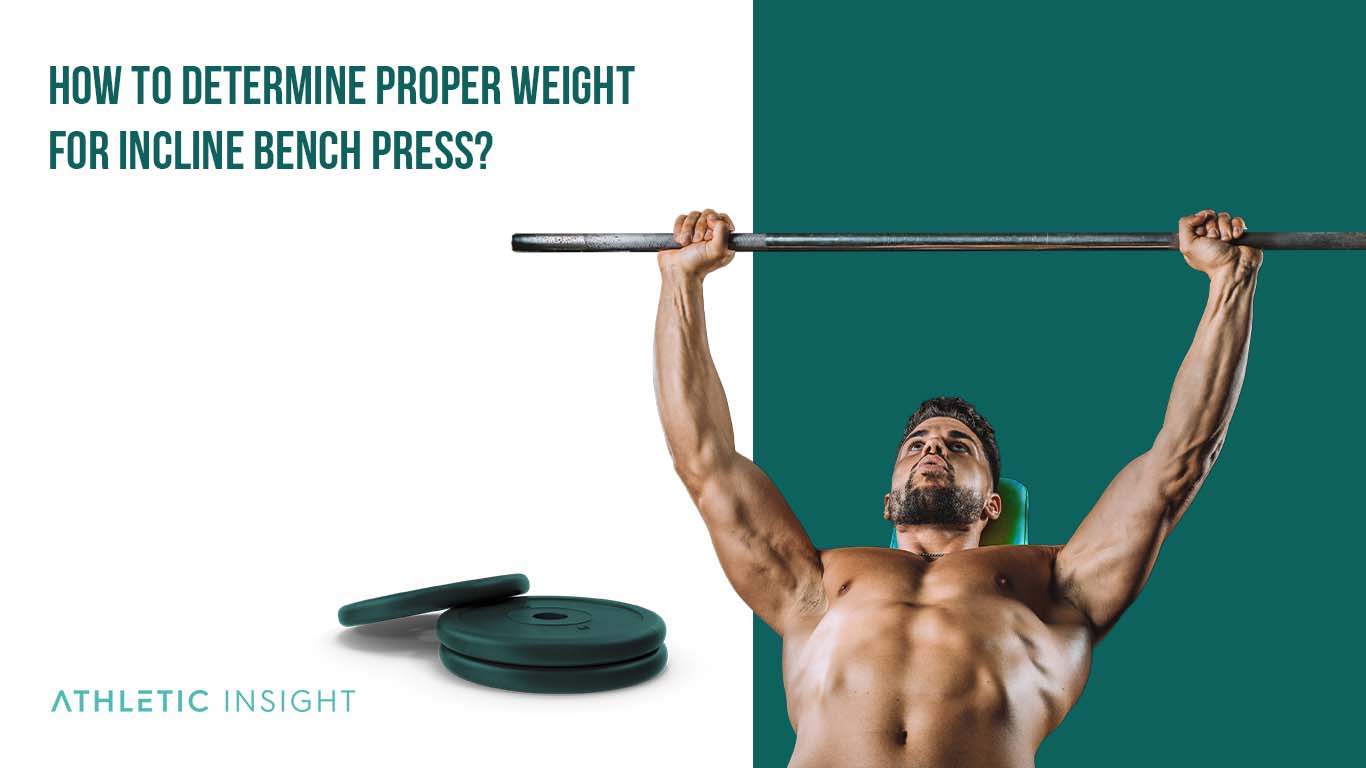
Your size, lifting experience, and build all come into play when determining a good weight benchmark for your unique workout plan.
Someone who trains often and is used to incline bench press training can potentially lift twice as much as a novice lifter.
For beginners, sometimes even the 45 pounds on a standard barbell incline bench press is more than enough to get started.
If even the barbell on its own proves too trying, you can also work with a 22-pound training bar. This way you can perfect your technique and ensure you don’t strain yourself.
Aside from practicing good form, you should always gradually build up your weight threshold to better maintain your gains.
On average, men can lift heavier loads than women, and are at the peak of their physical strength during their 20s and 30s.
Men between 20 and 29 can lift 100 percent of their body weight on average. Men between 30 and 39 can lift 90 percent. Those between 40 and 49 can lift 80 percent, and men between 50 and 59 can lift 75 percent.
While the incline bench press can be highly beneficial for women, fitness level and physical size are better indicators of the proper weight level needed for maximum results.
For example, a 97-pound woman without training can lift 50 pounds on average, while that same woman with extensive training can lift 115. If a woman is 148 pounds with no experience, she can lift 75 pounds. With proper training, she can reach 165 pounds.
Which Muscles are Involved While Performing Incline Bench Press?
There are a few different incline bench press muscles that work hardest during this exercise. They are listed in greater detail below, but the upper chest muscles, shoulder muscles and arms are the main muscles involved in the incline bench press.
1. Upper Chest Muscles
As mentioned before, the upper pecs are the main muscle that is targeted by the incline bench press. The proper name for these body parts is pectoralis major.
This superficial muscle is found on the anterior surface of your thoracic cage. It is divided into three separate parts, the abdominal, the sternocostal, and the clavicular.
These muscles are responsible for the internal rotation of your arms and shoulder joints.
Incline bench presses create strength and symmetry in your upper body muscles, including your upper pecs.
2. Shoulder Muscles
Inside your shoulder, three muscles act like a protective cap. These are the deltoids and they allow you to move on your arms outward and away from your body.
The deltoid is a thick, triangle-shaped muscle and the anterior deltoid is the front portion of that “triangle.”
The incline bench press produces almost as much muscle activity in the anterior deltoid as it does in the pectoralis major. This bench press variation also helps to target the middle delts to a lesser extent.
3. Arm Muscles
Around your elbow joint, you’ll find the medial head of your triceps brachii, which the incline bench press also targets.
The triceps brachii has three different heads that allow you to extend your elbow at the forearm. There’s the long head, the lateral head, and the deeply located medial head.
The entire triceps brachii is thick and shaped like a horseshoe on the posterior of your arm region. While all three of the TB heads have different origin points, they all combine to form a single tendon.
Unlike the long head, the medial and lateral heads are not connected to the shoulder joint. This means that shoulder angles activate the medial head better than flat benches.
What is the Importance of Grip for Incline Bench Press?
Though it might sound silly, before you start using incline bench press techniques, you should be aware of how important grip is to their success.
Grip strength is the key to handling more poundage in any lifting variant. When it comes to the incline bench press it’s doubly important, as grip strength allows for better grip stabilization and therefore better results.
If your wrists are flimsy, or your forearms shake, you will have much less control over your chosen weights.
How to Do Incline Bench Press
The best angle for a standard incline bench press is 45 degrees. Any bench press with an incline between 15 and 30 degrees is considered a low-incline barbell bench press that will only slightly target the upper chest area. Setting your incline bench to zero will only impact the middle portion of your chest. Anything past 45 degrees will start to work the shoulders more and more as it becomes a shoulder press.
If you want to dominate the incline bench press, you need to follow specific steps to master the lift. Read on below to find out just how to incline bench press like a pro.
- Lie on the incline bench and tighten your glutes and core
- Take a shoulder-width grip and hold tight
- Un-rack and position the bar
- Take a deep breath
- Lower the bar and ensure elbows are at a 45-degree angle
- Press the bar
1. Lie on the incline bench and tighten your glutes and core
First, assure the angle is correct, then adjust the height so that your eyes are directly under the bar. Plant your feet on the floor with your butt about 6 inches above the seat: Hold this position steady and assure that your feet are firmly planted and evenly spaced.
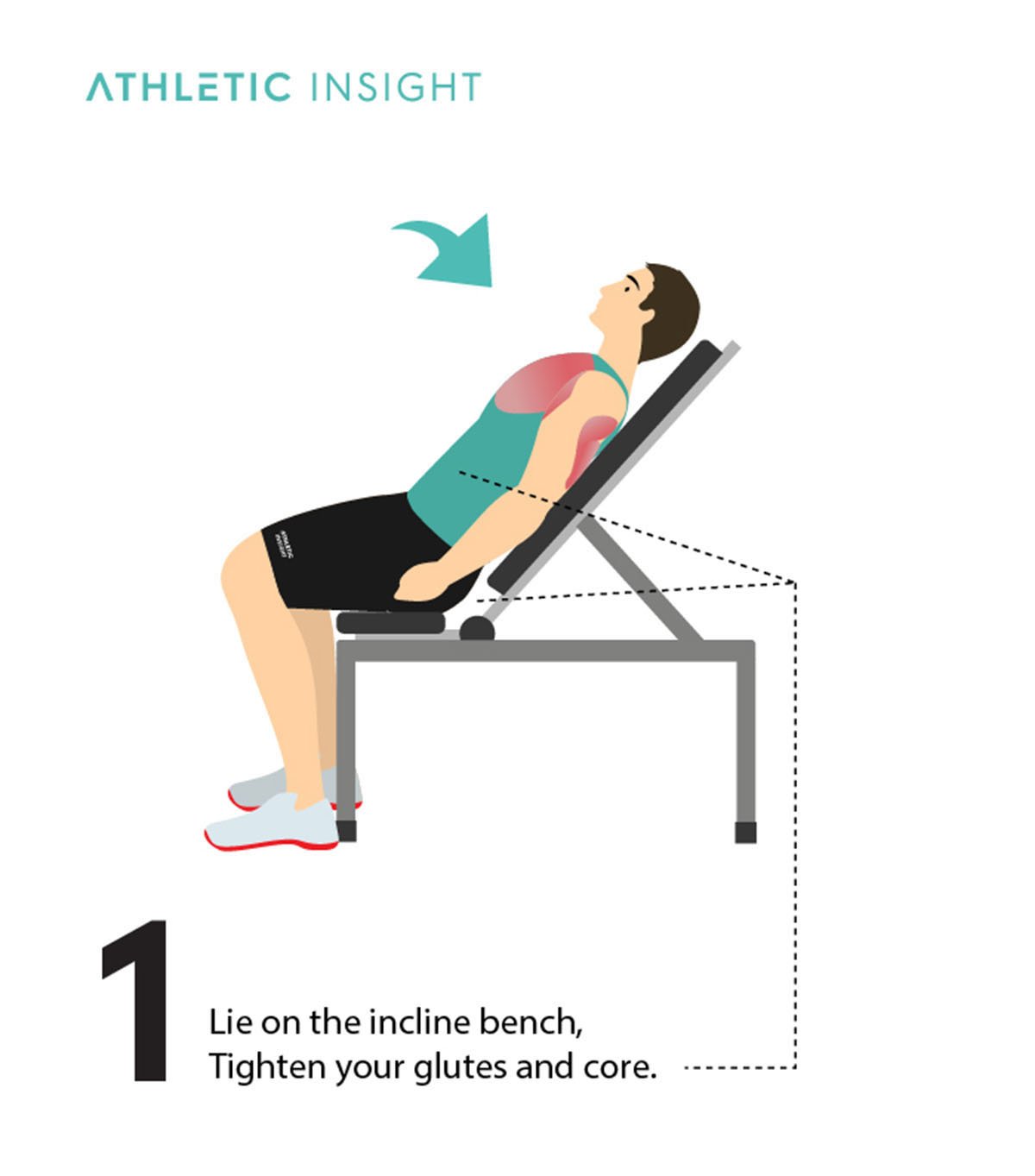
Slide yourself down so that your butt is on the seat without lifting your feet off the ground. Tighten you glutes and core by flexing these muscles. This will allow for a strong base while performing the exercise.
2. Take a shoulder-width grip and hold tight
Take a grip slightly wider than shoulder-width and hold the bar as tight as you can. This angle will allow for the most efficient bar path. A tighter grip will also allow for more weight to be pressed.
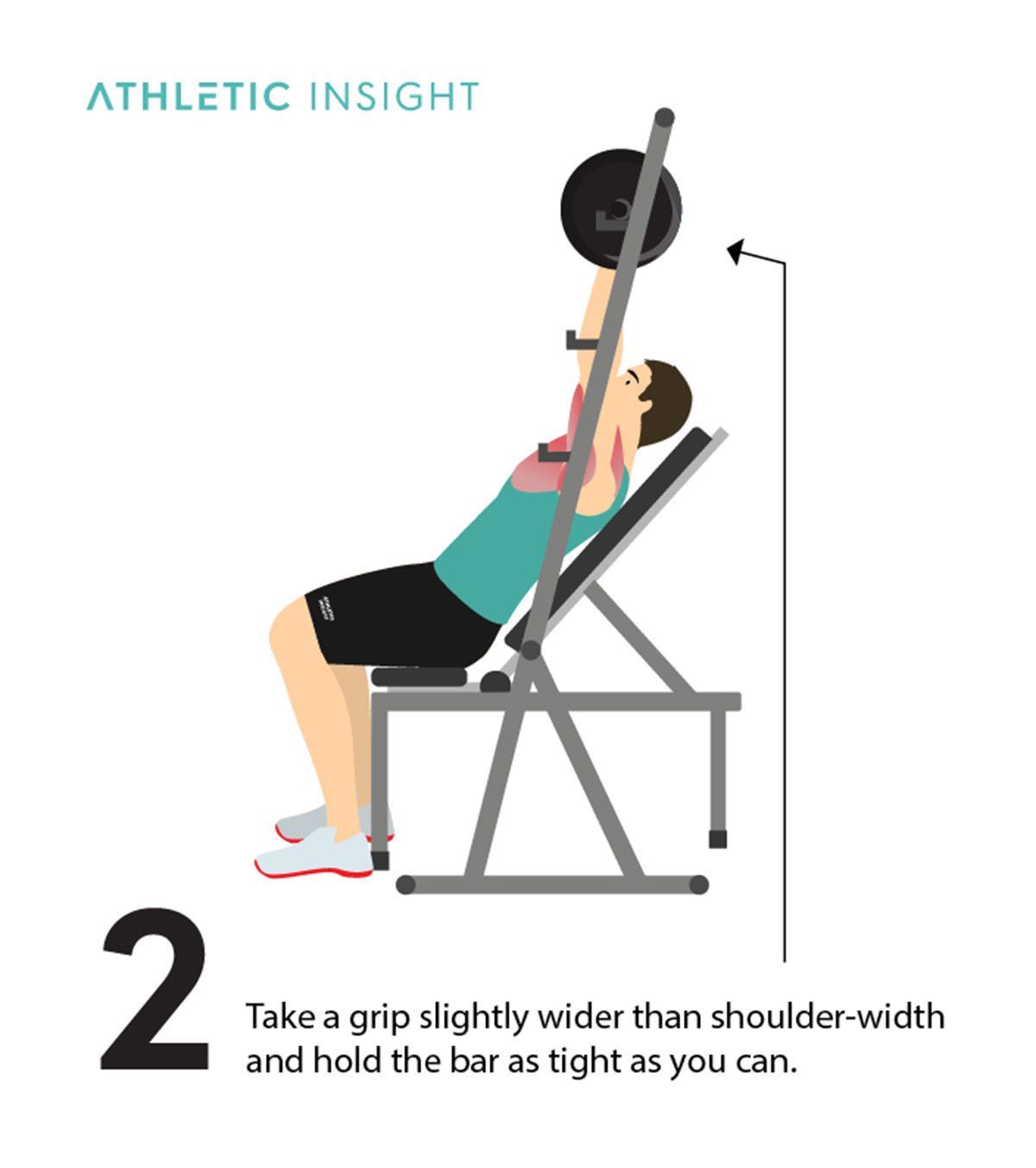
3. Un-rack and position the bar
Un-rack the barbell and bring it directly over your shoulders with your arms straight. Once you have done this, you enter the starting position of an incline bench press.
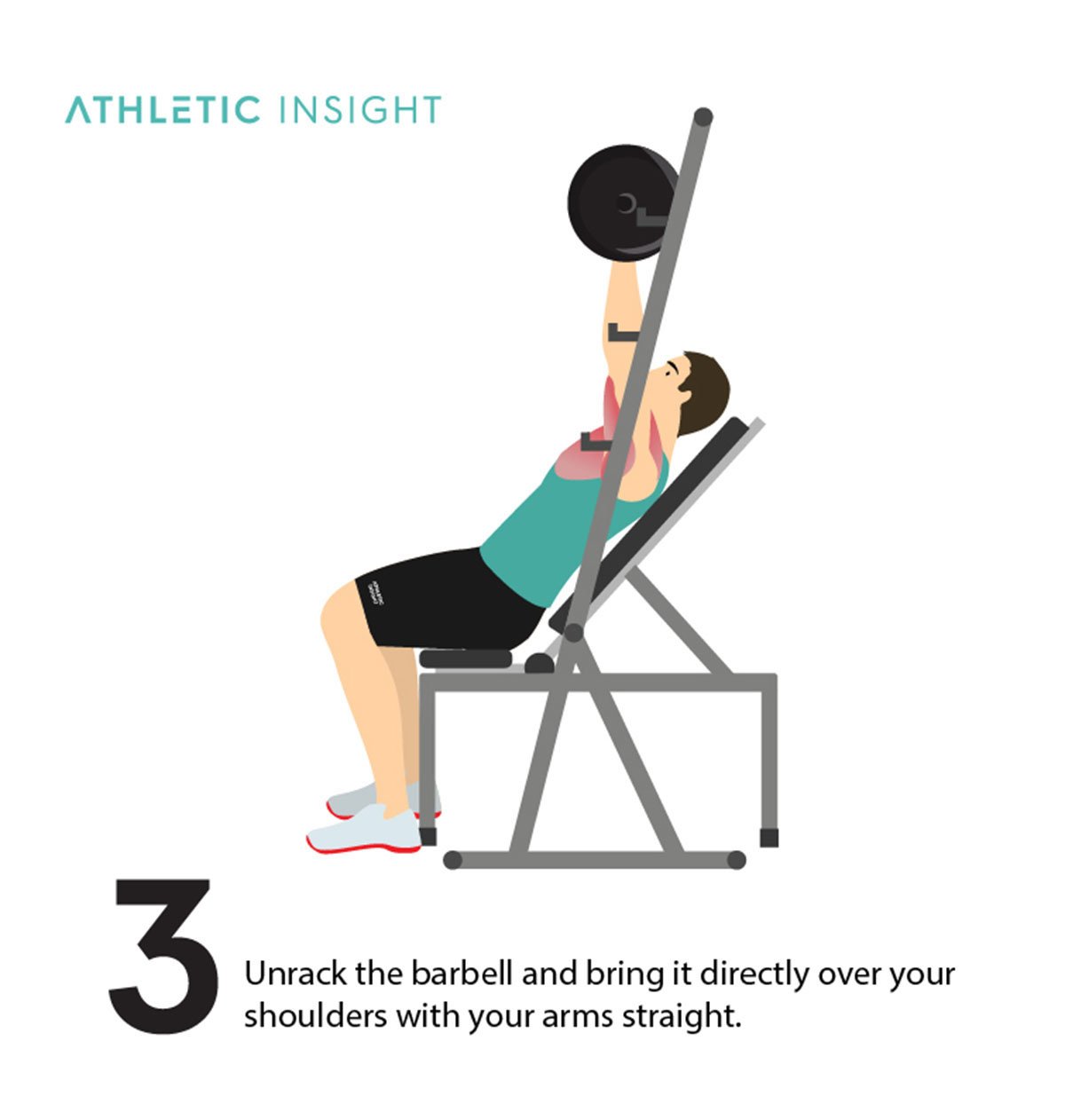
4. Take a deep breathe
Remember your form! Always monitor your breathing.
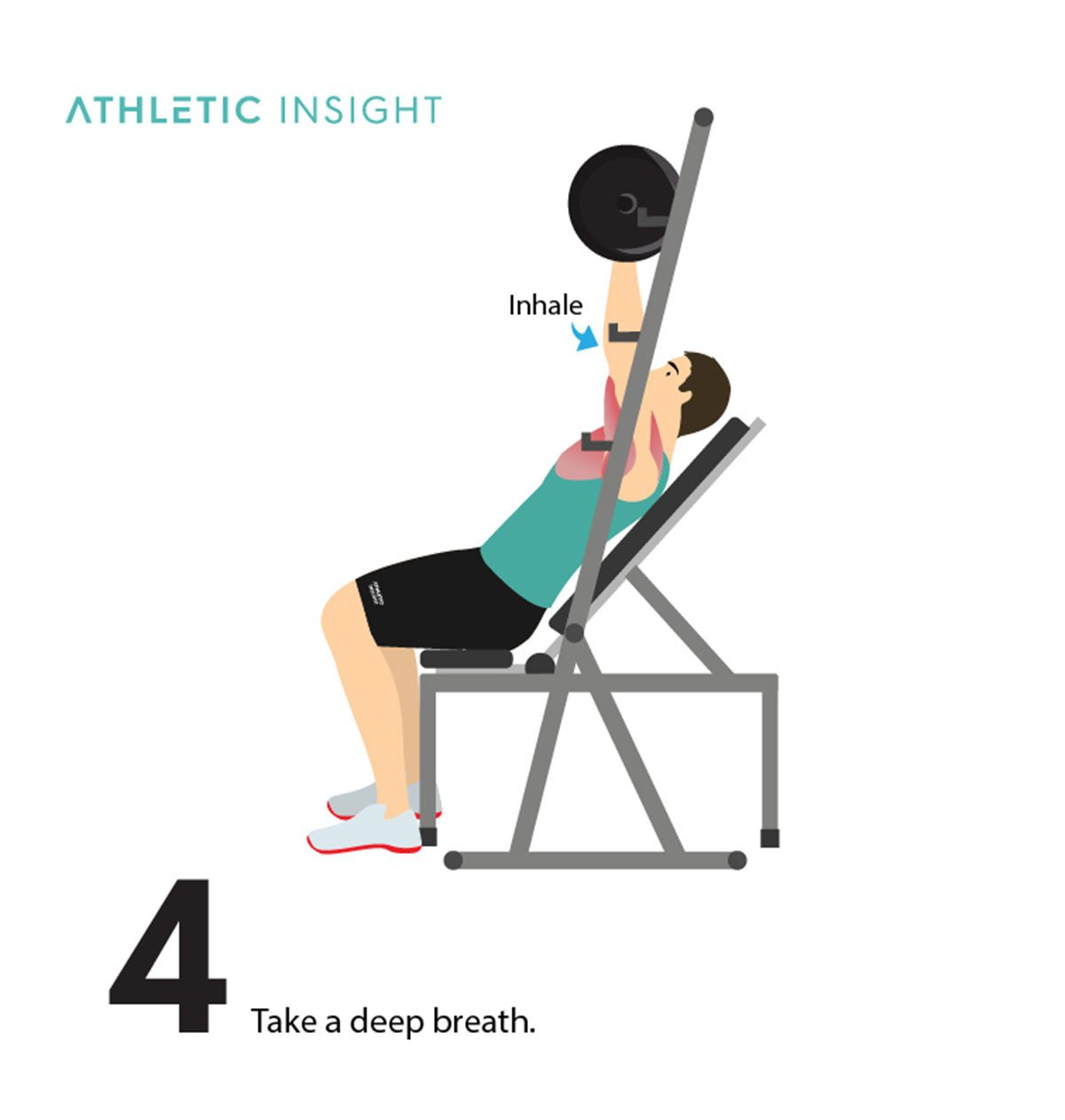
5. Lower the bar and ensure elbows are at a 45-degree angle
Ensure a slow descent to avoid injury or bouncing the bar too much. This controlled movement will ensure proper range of motion and prevent any muscle injuries. Carefully put your elbows at a 45-degree angle with your body. This angle creates an optimal range of motion for the bar to travel when you go to press the weight back up.
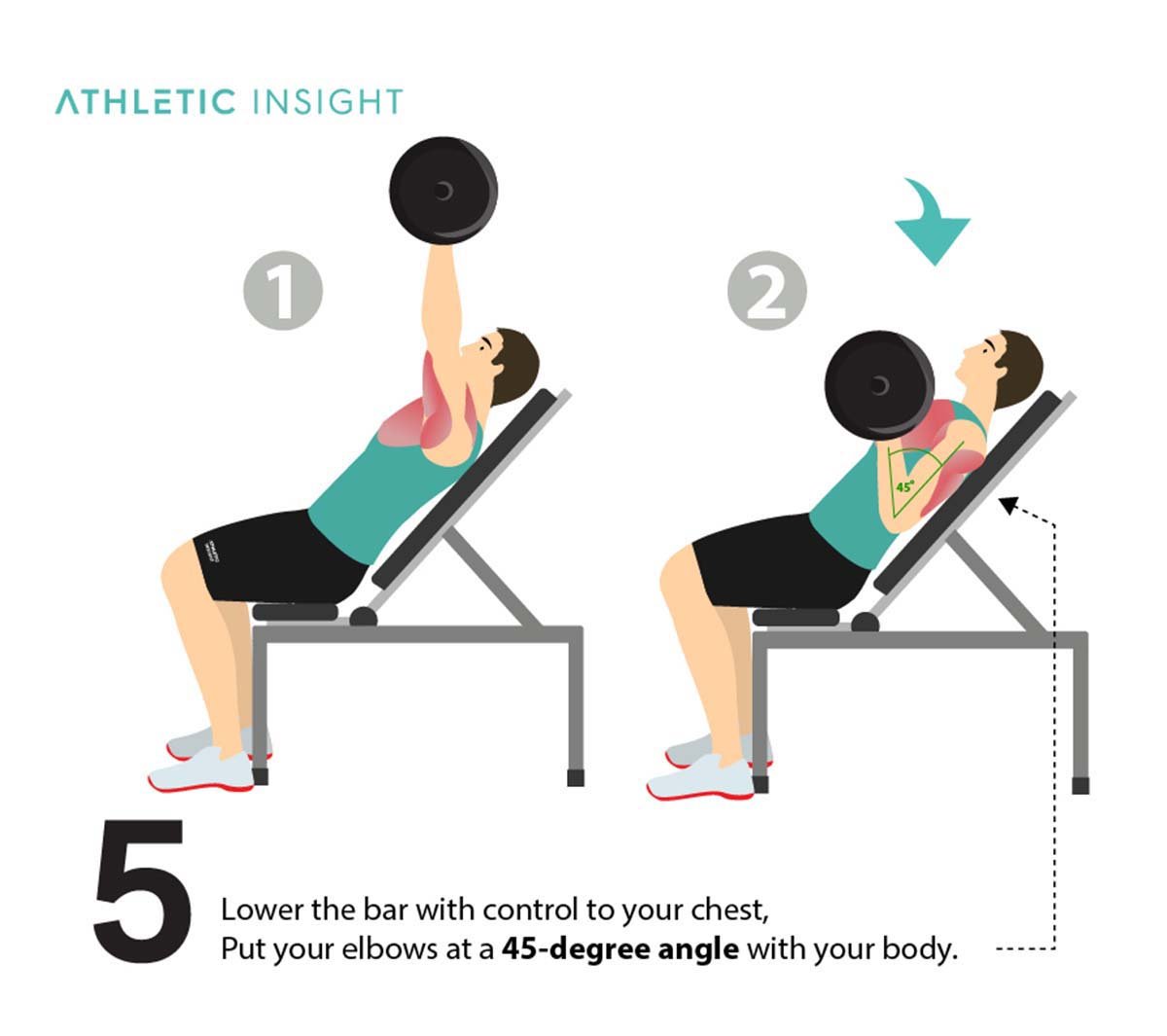
6. Press the bar
Press the bar up explosively and drive your feet into the ground to return to the starting position.
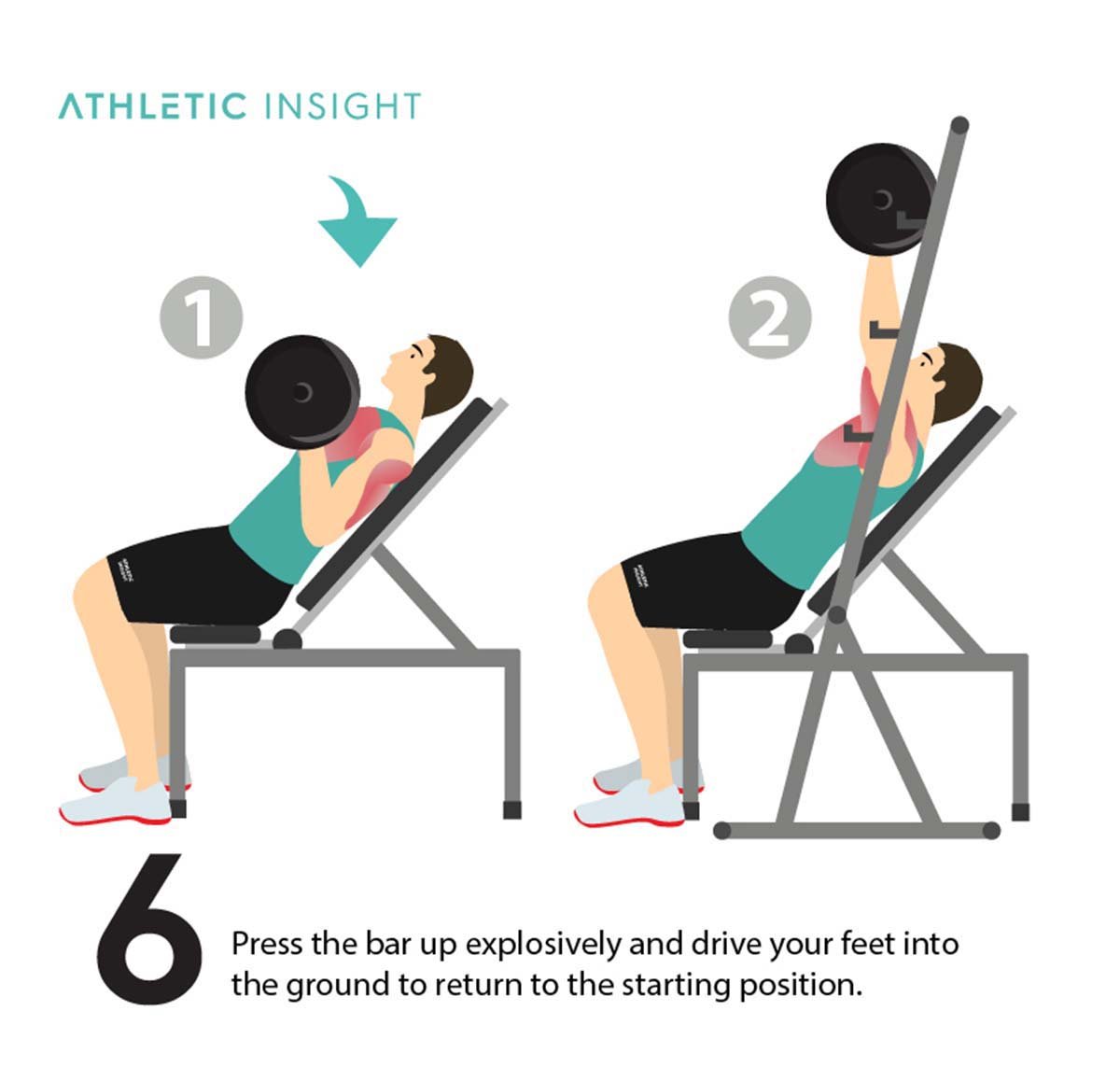
What Are the Incline Bench Press Variations?
We have already covered the broader bench press variations, but each subsequent variation uses different methods that target specific muscles and produce desired results. There are several different incline bench press variations to choose from, all of which produce various types of muscle definition and growth.
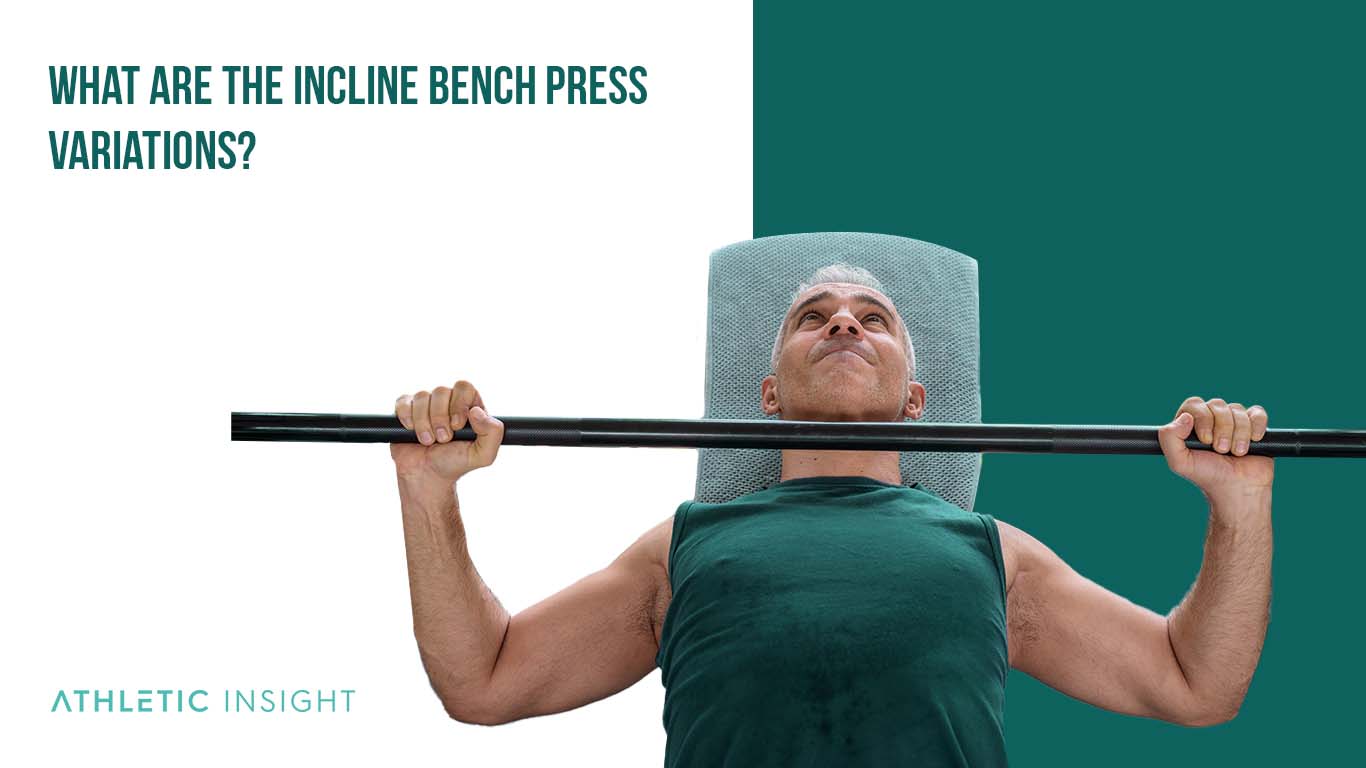
- Flat Bench Press
- Incline Barbell Bench Press
- Incline Dumbell Bench Press
- Close Grip Incline Bench Press
- Wide Grip Incline Bench Press
- Incline Dumbbell Crush Press
- Dumbbell Neutral Grip Incline Bench Press
- Alternating Dumbbell Incline Bench Press
- Top-Down Alternating Dumbbell Bench Press
- Glute Bridge Dumbbell Bench Press
- One and One Quarter Incline Barbell Bench Press
- Hammer Strength Incline Machine Press
1. Flat Bench Press
The flat bench press is another term for this basic bench press exercise. An incline bench press vs flat bench press is a little different because the flat bench is mainly a chest exercise.
When performing a flat bench press, you should still keep your feet firmly planted on the ground beneath the bench. You will also want to keep your shoulder blades squeezed tight as you lower the weight as well. Without the incline, you will notice different muscles are activated compared to lifting weights on a flat bench.
2. Incline Barbell Bench Press
This is the most common form of incline bench press variation and it is used to target your upper pecs, shoulders, and arm muscles. For this variation, you simply use a standard barbell, with or without weights attached, to target these muscle groups.
3. Incline Dumbbell Bench Press
The incline bench press dumbbell is another variation that substitutes a barbell weight for dumbbell weights. The dumbbell incline bench press is a simple variation that can be gentler on the shoulders and provides a wider range of motion than the incline barbell bench press.
4. Close Grip Incline Bench Press
The close-grip incline bench press variation mainly targets your tricep muscles, though it also adds definition to your shoulders and chest like most incline bench press techniques. This incline bench press variation is great for building strength in your triceps and can help with better elbow extension. For added benefit, this variation might even reduce stress on your shoulders during your workout.
5. Wide Grip Incline Bench Press
For the wide grip incline bench press variation, you will want to use a barbell instead of dumbbells. A wide grip is considered to be 1.5-2X the width between your shoulders.
A wide grip incline bench press produces maximum results in your pectoral muscles and maximum force off of the chest. It also gives you a better range of motion without the use of dumbbells. A wide grip bench press will target the pec muscles twice as much as the triceps when used instead of a narrow grip.
When doing the wide grip incline bench press, be sure to grasp the barbell a few inches wider than you would with a traditional barbell incline bench press.
6. Incline Dumbbell Crush Press
An incline dumbbell crush press is just like a dumbbell incline bench press with one minor difference. For this variation, you will want to keep the dumbbells in contact with each other throughout the whole exercise. You should actively squeeze your weights inward at all times with all your strength to ensure effectiveness.
7. Dumbbell Neutral Grip Incline Bench Press
A neutral grip is one in which your knuckles point laterally during weight lifting, like when you shake hands with someone. You can only use a neutral grip with dumbbells and certain weight machines.
8. Alternating Dumbbell Incline Bench Press
The alternating dumbbell incline bench press switches the weight between hands instead of holding a dumbbell in each hand. You want to grip the dumbbells with your palms facing away from you and breathe out deeply at every starting position.
9. Top-Down Alternating Dumbbell Bench Press
You begin this incline bench press variation with your arms fully extended above your chest and two dumbbells in your hands. Instead of lifting upwards, you lower one arm all the way down slowly from the top to a fully extended position. Then you push the weight back up in an explosive motion.
10. Glute Bridge Dumbbell Bench Press
The glute bridge dumbbell bench press is a variation of the traditional glute bridge exercise and the incline bench press. This variation lets you build endurance and strength in your glutes along with your shoulders, chest, and back.
11. One and One Quarter Incline Barbell Bench Press
For this incline bench press, you will need to place your grip shoulder-length apart on a barbell. Then slowly lower the bar to the base of your chest before pushing the bar one-quarter of the way up. You will then lower the barbell back down to the chest before pushing upwards till your arms are fully extended and locked.
12. Hammer Strength Incline Machine Press
An incline machine press is used just like a manual incline bench to produce a pressing movement pattern that defines and strengthens your chest muscles. The handles of the machine should look just like the ends of a barbell on a manual incline bench.
What Is the Necessary Equipment for Incline Bench Press?
To perform an incline bench press all you need is an adjustable weightlifting bench and your choice of weights. Choose from barbells, dumbbells, or kettlebells.
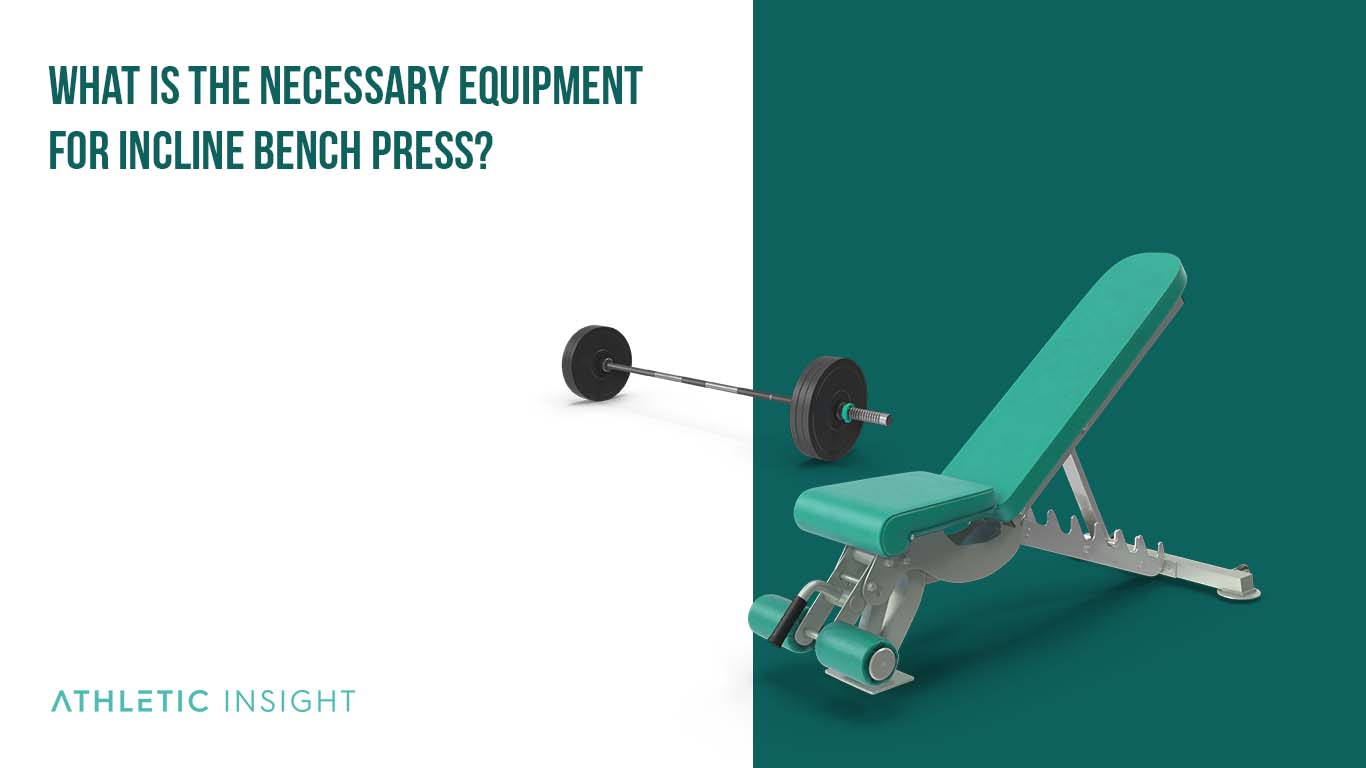
If you would like, you can also use chalk for grip, weight-lifting belts, or wrist bandages.
Or you can utilize an incline bench press machine instead, as with the hammer strength incline bench press variation. You can find incline bench machines at most gyms.
What is the Origin of Incline Bench Press?
The first-ever recorded bench press was performed in 1899 by a man named George Hackenshmidt. This novel performance would lead to a spike in popularity with strongmen and women around the world.
Hackenschmidt performed this precursor to the incline dumbbell press without a bench. That means he did it right from the bare floor.
Most bodybuilders of that time were not too worried about developing their pecs, even with the rising popularity of presses, and eventually bench presses.
By the 1940s and 1959s, strong pecs were en vogue, and many weight lifters turned to the bench press for help defining their chests.
The International Powerlifting Federation was formed in 1973, and official records were taken of the highest bench press records for the first time. Since then, several different variations on the flat bench press have been created.
That includes the incline bench press and all the variations the incline press spawned in turn.
What are the Incline Bench Press Related Facts?
The incline bench press is an optimal exercise to perform that targets not only the pectoral muscles, but also the frontal deltoids, latissimus dorsi, trapezius, and the core. The incline bench press can also be performed with a barbell, dumbbells, and even resistance bands which make it an easy exercise for most to perform.
Does Incline Bench Press affect the Hormones?
Yes, the incline bench press affects the hormones in one’s body. The incline bench press helps the body regulate anabolic hormones, which can trigger testosterone, IGF, and Human growth hormones.
Since the aforementioned hormones are involved in the growth and repair of muscle tissues, it’s no surprise that athletes see an increase in muscle gain. This exercise also increases the body’s metabolism which translates to burning off fat.
Does Incline Bench Press Increase Testosterone?
Yes, the incline bench press increases testosterone levels. Since testosterone is an anabolic hormone, it’s responsible for bone mass, muscle mass, and fat distribution. By performing the incline bench press, athletes prompt the body to produce more to help grow and repair the muscles.
Does Incline Bench Press affect the Mood?
Yes, the incline bench press affects the mood of the athlete performing the muscle movement. The main reason why the incline bench press impacts mood is because the body releases endorphins when conducting muscle movement, which makes people feel good.
Is Incline Bench Press Practiced within Crossfit?
No, the incline bench press is not practiced within CrossFit. However, having a strong chest will benefit CrossFit athletes which is why the incline bench press is still an effective exercise for these athletes to perform.
Is Incline Bench Press a Military Movement?
No, the incline bench press is not a Military movement or part of any Military testing procedures. Still, having a developed chest will benefit Military members and is still considered an effective exercise for servicemembers to train.
Is Incline Bench Press Dangerous?
Yes, the incline bench press is dangerous. Not only are you lifting a heavyweight over your head, which requires a spotter, but you are placing a lot of stress on major joints. The most common muscle strain is a torn rotator cuff.
The rotator cuff consists of four main tendons and muscles surrounding your shoulder joint. They are responsible for stabilizing the joint and moving the shoulders. These tendons and muscles are generally the weakest part of the shoulder. If you don’t warm up before performing an incline bench press, you can easily tear or inflame them.
You can also develop subacromial bursitis, which happens when you put too much pressure on the sacks of fluid that decrease rubbing and friction in your shoulders muscles. You can also tear or inflame your pectoral muscles or glenoid labral. The glenoid labral is a soft tissue cuff that surrounds your shoulder socket.
Is Incline Bench Press Push or Pull?
The incline bench press is a push exercise that targets the pectoral muscles, mainly the upper pectorals.
Is Incline Bench Press Essential?
Yes, the incline bench press is an essential exercise if you are looking to gain muscle and strength in your chest. Additionally, the incline bench press is an important muscle movement if you want a well rounded chest, as there is no better exercise for developing the upper pectorals.
Is Incline Bench Press an Olympic Lift?
No, the incline bench press is not an Olympic lift. However, since the pectorals are a critical muscle to train, even for Olympic athletes, it is still an effective exercise to add to your routine.
Is Incline Bench Press a Compound Exercise?
Yes, the incline bench press is a compound exercise. Since the incline bench press exercises the chest, shoulders, and triceps, it is considered a compound exercise.
What can Replace Incline Bench Press?
While the incline bench press is an effective weightlifting exercise to conduct, there are some alternatives and variations that can replace it. Some of these include the decline pushup, incline Swiss ball dumbbell press, incline chest press with bands, front raises for chest, reverse grip rotational dumbbell press, incline dumbbell bench press, and the hammer strength incline machine press.

